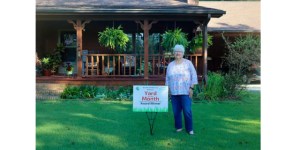Growings On: It’s starting to get noisy outside. Spring is coming. Are you ready?
Published 2:00 pm Wednesday, February 28, 2024

- Shane Kornberg
Every year it surprises me when we have a morning in late January or early February when the high-pitched sound of spring peepers fills the air. Every time, I think, “Already?”
This is an audible sign that spring is coming and that we should start thinking about preparing. This year, on the same day I heard the spring peepers, I also heard the chaotic honking and cackling of Canadian geese beginning to break away from the flock and start sorting into mating pairs. They will typically squabble and scrap as they pair off and pick out the nesting site for the year. I don’t fully understand the cause of the commotion, but I imagine that it’s akin to any couple having to make important family decisions. They mate for life and typically nest in the same areas every year, but as populations change they are forced to defend their nest site and work out territorial disagreements with new neighbors.
Trending
The spring peepers are making all that noise in the name of family planning as well. They come out of the woods in search of small, wet-weather puddles and ponds looking for mates. The high-pitched peeping sound is produced by the males looking to attract a female. These small brown tree frogs with a unique x on their back will lay their eggs in a temporary pond or wet spot if possible to avoid getting eaten by fish. The eggs only need a couple of weeks to hatch into tadpoles and then a couple of months to transform from tadpoles into frogs. At this point, they will head to the woods to do what tree frogs do and eat insects.
These noises serve as a reminder that spring is around the corner, and if we pay attention we can use it as a cue to start preparing our gardens and landscapes for spring. This is a great time to prune non-flowering plants and summer flowering plants. It’s best to wait and prune spring flowering plants after they have bloomed, otherwise you will remove the flower buds formed the previous fall. Proper pruning can improve the shape of plants and shrubs, reduce the overall size, and allow for the removal of diseased and damaged limbs.
Understanding what happens when a terminal bud is removed is important in understanding how to prune. Under normal conditions, the terminal bud (at the end of a branch) suppresses the growth of lateral buds (those along the branch) through a hormone called auxin. When the terminal bud is removed, the flow of auxin is reduced and the lateral buds begin to grow. Most new growth occurs near (six inches to eight inches) the pruning cut.
Commonly, homeowners and even some commercial landscapers only shear and shape the outer portions when they’re pruning. Unfortunately, this results in thick growth at the surface and doesn’t allow sunlight to penetrate the plant. This can leave the shrub with a hollow appearance, a look of sparseness. Thinning cuts, selectively removing entire limbs or shoots from larger stems, allow light into the shrub. This encourages interior growth for a more natural form and a fuller-looking plant.
If you have shrubs that have outgrown their space, early to mid-March is a good time to consider renewal pruning. Renewal pruning means aggressively cutting the plants back to six to 12 inches above the ground.
Timing is important. Pruning too early may encourage new growth that gets injured by cold weather.
Trending
While most broadleaf plants respond well to renewal pruning, boxwoods can be damaged if pruned too severely. Evergreens such as junipers, Leyland cypress, cedar and arborvitaes should never be aggressively pruned. They may even die if over half their foliage is removed. When these species get overgrown, consider transplanting, and when planting, always remember this: “Right plant, right place.”
The best time for pruning and the best method depend on the species. If you have any questions regarding pruning in your yard, give us a call, and don’t forget to listen for those sounds of spring.
Prune before spring growth begins
Beautyberry
Camellia
Chaste tree (vitex)
Cranberrybush viburnum
Crape myrtle
Floribunda roses
Fragrant tea olive
Glossy abelia
Goldenrain tree
Grandiflora roses
Japanese barberry
Japanese spirea
Mimosa
Nandina
Rose-of-Sharon (althea)
Sourwood
Anthony waterer spirea
Sweetshrub
Prune after flowering
Azalea
Beautybush
Bigleaf hydrangea
Bradford pear
Bridalwreath spirea
Clematis
Climbing roses
Crabapple
Deutzia
Dogwood
Doublefile vibernum
Flowering almond
Flowering cherry
Flowering quince
Forsythia
Japanese kerria
Japanese pieris
Lilac
Mock orange
Oakleaf hydrangea
Pearlbush
Pyracantha
Redbud saucer
Magnolia star
Magnolia shrub
Honeysuckle
Thunberg spirea
Vanhoutte spirea
Weigelia
Winter Daphne
Wisteria
Witchhazel
Shane Kornberg is the agriculture and natural resource agent for University of Georgia Extension, Whitfield County. Contact him at Kornberg@uga.edu or call the Whitfield County Extension office at (706) 278-8207.





